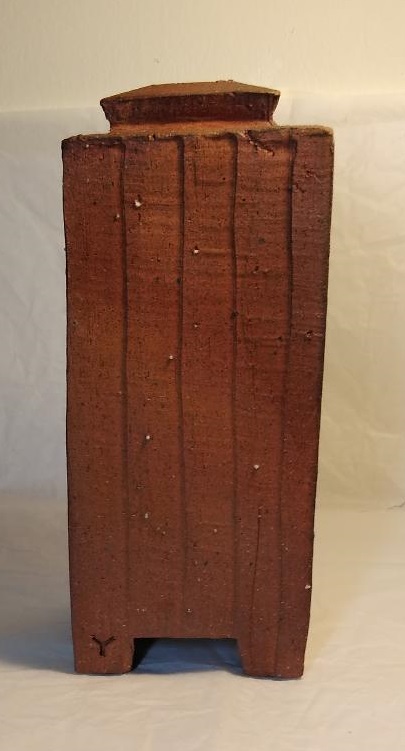119. Large Oribe altered platter, ca. 1920
Coarse gray clay, glazed in green, yellow, and cream; slip decorations in brown, foot ring and part of base left unglazed. Weight: 1538 g (3.4 lb). Rim dimensions: 32.7 x 27.7 cm (13 x 11 in); foot ring diameter: 15.3 cm (6 in). Height: 4.5 cm (1-3/4 in).
The date is that given by the seller, who researched the artist’s mark on the base and found the same mark on pots dating to the late Taisho, early Showa periods, roughly 1912–30.
This sits on the base of the foot ring. On the exterior the foot ring is about 0.6 cm (¼ in) high; the interior of the base has been hollowed out to a depth of about 1 cm (3/8), The artist’s mark was pressed into the interior of the base. The characters are in seal script and the lines very faint. From the foot ring, the sides rise in a shallow outward arc to the rim. Along what are now the long sides of the plate, the middle section of each side has been curled inward to create a semi-straight line. On each of these sections are three semi-circular dents of uneven size and irregular spacing; they match the spacing of my fingers and may have been made by pressing the fingers into the clay. Each of the shorter sides also has three semi-circular dents. These are more evenly spaced and more regular in shape; they appear to have been made by pressing something like the handle of a tool into the clay. There are three holes in the walls of the plate along the shorter sides, two on one side and one on the other. The ends of a handle (probably made of plated vegetable stalks—rattan or bamboo fibers—wrapped around a metal wire) would have been inserted into these holes.
The bottom of the foot ring and the outer portions of the interior of the base were left unglazed. Judging from the overlays of the glazes, the cream portion was laid down first along the interior and portions of the exterior. The yellow glaze was next, followed by the green glaze. The cream is visible only in the portion of the interior surface not covered by the other glazes, along one portion of the exterior rim otherwise covered by the green glaze, a portion of the exterior walls just above the foot ring in the area of the green glaze, and in the interior of the base. A brown slip was used to paint two chrysanthemum-like flowers on the interior of the dish in the cream area, and half a chrysanthemum on the cream-colored area along the rim. The cream-colored areas have a fine crackling. Incised into the area of the interior covered by the yellow glaze are the leaves, flowers, and stems of a plant.
This piece is unusual not only for its size and altered shape but for the combination of painted and incised designs. Considering its age, it is in good condition; the bottom in particular shows signs of wear and use. About the only use I can imagine for this is to present a selection of sushi.
Purchased in March 2021 from Stoneware Treasury in Bangkok, Thailand.










































